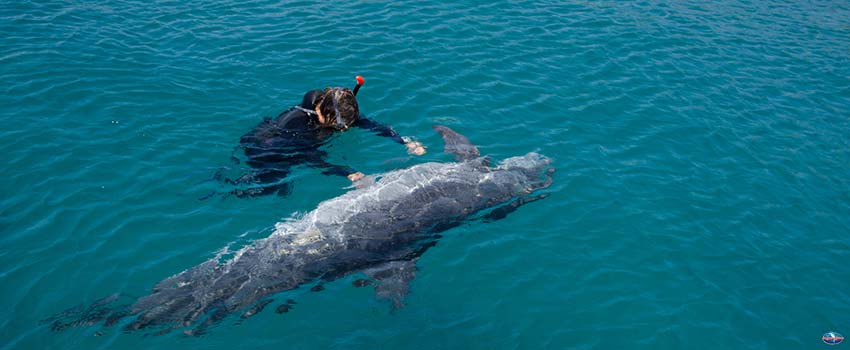Have you ever wondered how dolphins communicate with each other? Aside from the squeaks they make, do they have their own language, or do they depend on gestures? If you have these questions in mind, you’ve come to the right place. This guide will cover everything you need to know about dolphin communication and the possibility of a dolphin language.
Dolphins are one of the most intelligent animals on Earth. They have a complex communication system to talk to each other for fun, survival, and social interaction. Scientists are only beginning to understand how dolphin communication works, but one thing is certain: marine mammals can communicate with each other, even though we don’t understand their language.
Prepare to be fascinated not just by dolphin intelligence but also by the elaborate system of communication these marine mammals have evolved since they first appeared on Earth five million years ago. If you’re ready, let’s get started!
Do Dolphins Have Their Own Language?
Dolphins use a variety of sounds to communicate with each other. Up to this day, scientists are still trying to figure out if these dolphin sounds make up their language.
Muscles in dolphin blowholes change the shape and size of the blowhole opening to create sounds. Dolphins can manipulate the size and shape of the blowhole to communicate with other dolphins within their pods and even groups far away. Those in captivity also use these sounds to communicate with each other and get the attention of their caregivers.
How Do Dolphins Talk to Each Other?
Dolphins use sounds to talk with each other. They talk using a wide range of actions and dolphin sounds, such as clicks, whistles, and loud broadband packets called burst pulses. What’s more amazing is that they also communicate using nonverbal gestures, just like humans.
Researchers from around the globe have collected data about a wide variety of nonverbal gestures and sounds dolphins use to communicate with one another. They believe these mammals use a complex system of communication.
According to some research and observations, here are some types of dolphin communication:
1. Signature Whistles
Signature whistles are unique whistles made by dolphins that identify them to other dolphins using frequency modulation patterns. These dolphin sounds develop as early as two years old. However, some dolphins may change their whistle after several years of using the same signature whistle. In particular, male dolphins tend to alter their signature whistles when they form an alliance with another dolphin.
Research has also shown that dolphin groups often exchange signature whistles when they meet at sea to share information about their identities and aid in socializing. This means that dolphin groups can immediately interact when they encounter one another.
Dolphins are also known to copy the signature whistles of other dolphins. Researchers recorded the calls of wild and captive dolphins to gain more insight into why they mimic signature whistles. The researchers found that only dolphins with close social bonds, such as young males in captivity and calves and their mothers, copy each other’s signature whistles.
Some dolphins copy signature whistles from an offspring or pod member. One theory says that dolphins mimic each other’s signature whistles to call other dolphins. It could be one of their ways to get acknowledgment from pod members or to signal their proximity and availability for social interactions.
2. Social Communication
Aside from signature whistles, dolphins also communicate without sound. They also talk to each other without using their vocal organs, such as the air sacs and larynx, to produce dolphin sounds.
Tail slapping is one of their nonverbal gestures. It is a sign that a dolphin is discontented and can be used to deter predators. It could also signal the group to leave a certain area. Since tail slapping is an attention-getting sound, researchers concluded that it could be an effective way to signal without vocalizing.
Breaching is another nonverbal gesture used by dolphins, where they remove their entire body or part of it from the water, then crash forcefully onto the water’s surface. While some dolphins do this to remove parasites from their bodies, it is also one of their ways to communicate with the other members of their pod and help them herd prey towards each other.
3. Echolocation
Echolocation is another type of dolphin communication. Now, you might be thinking: “What is echolocation?” It’s a process that uses sound waves to locate food and other dolphins. With echolocation, dolphins can locate objects in the ocean, even those from hundreds of miles away.
Now that we’ve answered the question, “What is echolocation?” it’s time to learn how it works. Dolphins can pinpoint the exact location of objects by producing short pulses that sound like clicks to humans. The sound waves bounce against objects and are picked up by a highly-evolved fat-rich region of a dolphin’s lower jaw, transmitted to the middle ear, and then to its brain, which interprets the sound.
Dolphins have a fine sense of echolocation. They can distinguish between a ping pong and a golf ball by their density. The way water conducts sound is a factor that supports a dolphin’s successful use of echolocation. Dolphins are the best echolocators among mammals, as sound travels four times faster in water than in air.
Research into echolocation’s evolution in bats and dolphins has revealed another fascinating fact about echolocation. In 2010, a study found that both bats and dolphins had identical mutations in prestin, a gene responsible for hearing loss. Further investigation of other genes that influence hearing revealed that prestin and several other proteins were altered in bats and dolphins. This strongly supports the hypothesis of convergent evolution in echolocation in both species.
Interact with Dolphins
If you want to witness how dolphin communication works, Sunshine Scenic Tours has you covered! We provide the most exciting and educational dolphin cruise in John’s Pass. Our crew can take you to the best spots to see dolphins interacting with each other. You might also spot some baby dolphins swimming with their mothers if you’re lucky enough.
For bookings and inquiries, don’t hesitate to reach out. We look forward to giving you the highlight of your trip to Treasure Island. Contact us today!











